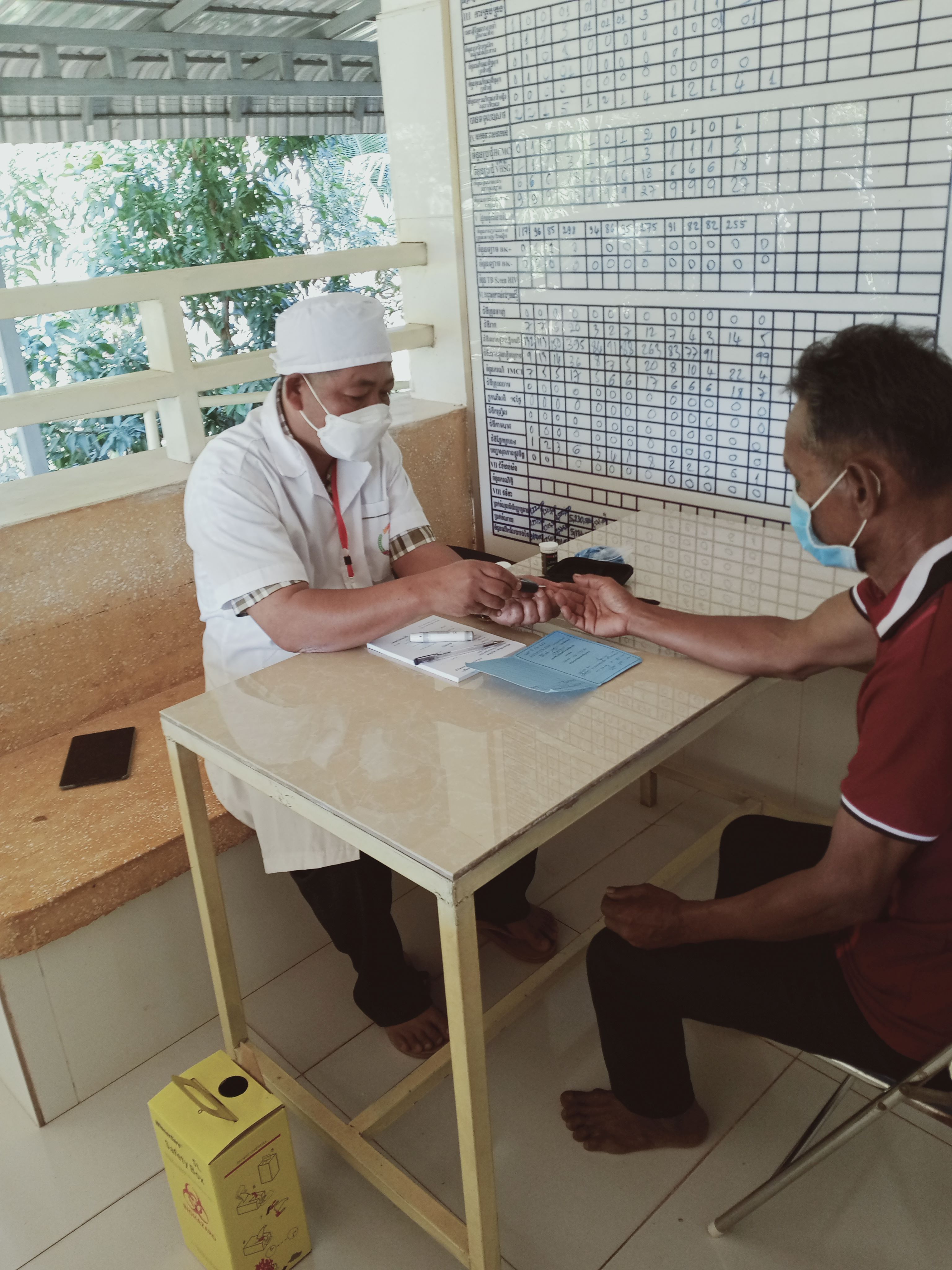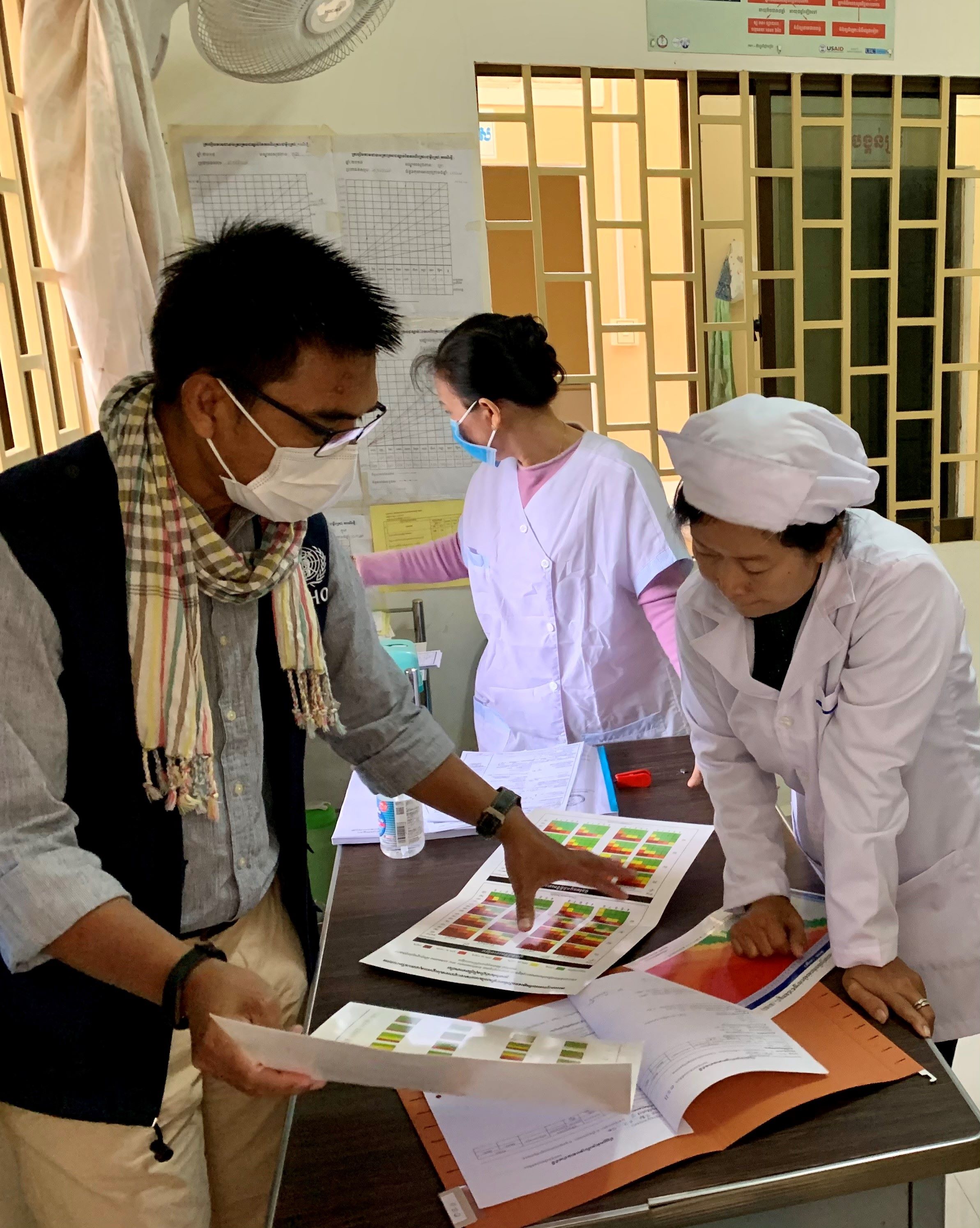“I come to the health center every 10 days to get hypertension medicine. I feel better. My blood pressure is under control, and I do not have neck pain and dizziness anymore. Thank you, health staff,” Mr Soeun said to Dr Khim Sam Ath, Technical Officer at the World Health Organization (WHO), when asked about his health status and how he gets access to treatment for his illness. “I am very happy because the health center can treat me near my home. If it is too far, it is difficult for me to get to, and I don’t have the money to go to the hospital. I need a lot of medicines to treat my illness. I also wish to have a lot of medicines at the health center to treat and help other people with hypertension.”

Prak Putratha, a nurse at Prey
Thnorng Health Center in Kampot Operational District, Kampot province conducted a screening of diabetes for Mr Soeun, a hypertension patient during medical consultation.
© Prey Thnorng Health Center
Similarly, Ms Ainy said, “I found out about my diabetes around 7 years ago when a hospital doctor told me that my fasting blood sugar was 200-300. I felt difficult inside, poor sleeping, thirsty and tired even though I was eating a lot. I spent a lot of money and almost sold my property to treat my disease at hospital. Every visit to the hospital, I spent between 200,000- 300,000 Riels (about 50 to USD73) to do the many tests for my illness. But after the hospital doctor referred me back to collect medicines and receive follow-up treatment at the health center near my home, I feel much better. My fasting blood sugar is 132. I pay only 5,000 Riels (about USD1.25) per visit at the health center. I wish health staff could treat all people with diabetes. I thank the health staff so much for providing me health education on lifestyle changes. I have followed their advice and counselling. I wish to live a long life with my disease.”
It is stories like these, heard by heath care workers every day, that highlight the need for effective, local and affordable treatment of noncommunicable diseases (NCDs) across Cambodia. The World Health Organization has been working with the Royal Government of Cambodia to train regional health workers, manage information and strengthen NCD services at the primary health care level.

Dr Khim Sam Ath, Technical Officer
at WHO provided on-job training and explained to nurses at health centers on cardiovascular risk assessment and management, 12 November 2020, Battambang province.
© PMD/Seng Rattana
NCD’s in Cambodia – a growing health problem
“The significant increase in the prevalence of noncommunicable diseases (NCDs) has been associated with demographic and environmental changes, urbanization and unhealthy lifestyle. We need to continue working for our future generations in preventing NCDs,” said Dr Nargiza Khodjaeva, Technical Lead on NCDs and Health throughout the Life-course, WHO. Like many countries around the world, Cambodia is facing a growing burden of NCDs. In 2018, NCDs accounted for 64% of all deaths in Cambodia. One in every four Cambodians (23%) dies prematurely, before the age of 70 years, from one of the four main NCDs, including cardiovascular disease, cancer, diabetes, and chronic respiratory disease. These NCDs are imposing public health challenges and a socioeconomic burden on a country coping with the rising cost of treatment, and on families through loss of income, out-of-pocket expenses and catastrophic health-care costs. Poor people face the greatest hardship. According to the case for investment in the prevention and control of NCDs, these diseases are imposing significant costs on the Cambodian economy. A total of USD 1.5 billion is lost every year, representing close to 7% of GDP.

Ministry of Health launched the case for investment
in the prevention and control of noncommunicable diseases in Cambodia, 02 October 2019.
© WHO/Yel Daravuth
Strengthening NCD services at primary health care level
Together, the World Health Organization (WHO) has been working with the Ministry of Health and partners to establish a primary care model for NCD prevention, care, and management at health centers and referral hospitals, focusing on early detection and management of hypertension and diabetes through building capacity of health centers and referral hospitals, providing community based NCD education, and developing a Cambodia NCD management information system.
As of December 2021, NCD services have been established at 137 health centers and 31 referral hospitals across the country. Over 400 health center staff from different provinces attended capacity building trainings on the WHO Package of Essential NCD Interventions for Primary Health Care (WHO PEN) held by Preventive Medicine Department (PMD) from the Ministry of Health. Nurses at health centers gained knowledge and skills on hypertension and diabetes management, cardiovascular risk assessment and health education and counseling for healthy behavior in primary care. The PMD also provided training to over 600 Village Health Support Group (VHSG) on NCDs who would become volunteer in community based NCD education integrated into preventive health services.
“Having participated in a five-day training on diabetes and hypertension management in primary care, I have additional skills to treat hypertension and I feel confident to provide follow-up treatment to diabetes patients at my health center,” said Mr Prak Putratha, a nurse at Prey Thnorng Health Center in Kampot Operational District, Kampot province. “I have better understood NCD risk factors and know how to provide health education and counseling for healthy behavior to people.”

Dr Muy Seanghorn, Deputy Director of
Preventive Medicine Department, the Ministry of Health opened training of nurses on diabetes and hypertension management in primary care, 23-27 November 2020.
© PMD/Seng Rattana
Ms An Chenda, Responsible Officer for NCD programme at Kampot Operational District (OD), Kampot province told Dr Sam Ath that “in the future, the health centers need to run its services by themselves to provide NCD service delivery. Community campaigns on NCDs should be conducted more often to provide knowledge and information to people and patients in the community. After COVID-19 situation allowed, the OD will work with health centers to do blood glucose test people in the community or at their home within 14 health centers in OD Kampot.”
WHO has provided medical equipment and materials for early detection and diagnosis of NCDs to relevant health centers and referral hospitals. As a result, a total number of populations screened for hypertension and diabetes including cardiovascular risk has been increased from 1,426 people in 2019 to over 20,000 people in 2021.

Nurses conducted diabetes
screening and provided health education for healthy behavior and treatment at health centers, Kampot province, 02 December 2020.
© WHO/Khim Sam Ath
The Royal Government of Cambodia’s plan to combat NCDs
WHO has provided technical support to the Cambodian Ministry of Health to develop the National Strategic Plan for the Prevention and Control of NCDs 2022- 2030. The plan will help to tackle NCD’s in the country by:
- Curbing the surge of NCDs by combatting risk factors, including through regulation and tax increases for tobacco products, alcohol and sugar-sweetened beverages, and encouraging healthy physical and social environments;
- Prioritizing NCD services through people-centred primary health care, universal health coverage, and support for management of chronic illnesses such as diabetes and hypertension, as well as rehabilitation and palliative care when needed; and
- Monitoring NCD trends and their risk factors to better inform health policy through applying innovative, evidence-based surveys, and research.
While much has been achieved to lessen the impact of NCDs on the Cambodian community, much more needs to be done. In the future, we hope that all people like Mr Seoun and Ms Ainy can be treated at health centers close to home.
“សូមអរគុណបុគ្គលិកសុខាភិបាលទាំងអស់!”ក្រសួងសុខាភិបាល អង្គការសុខភាពពិភពលោក និងដៃគូអភិវឌ្ឍន៍ សហការគ្នាដើម្បីបង្ការ និងគ្រប់គ្រងជំងឺមិនឆ្លងនៅកម្ពុជា
“ខ្ញុំមកមណ្ឌលសុខភាពរៀងរាល់១០ថ្ងៃម្តង ដើម្បីមកទទួលថ្នាំលើសឈាម។ ខ្ញុំរាងធូរស្រាលច្រើនហើយឥឡូវនេះ។ សម្ពាធឈាមរបស់ខ្ញុំស្ថិតក្នុងសភាពអាចគ្រប់គ្រងបាន ហើយខ្ញុំលែងឈឺក និងវិលមុខដូចពីមុនទៀតហើយ។ ខ្ញុំសូមអរគុណបុគ្គលិកថែទាំសុខភាពដែលបានព្យាបាលជំងឺខ្ញុំ។” បងប្រុសសឿន បានរៀបរាប់ដូច្នេះប្រាប់លោកវេជ្ជបណ្ឌិត ឃឹម សំអាតដែលជាមន្រ្តីបច្ចេកទេសនៃអង្គការសុខភាពពិភពលោក នៅពេលដែលបងប្រុសត្រូវបាន សាកសួរអំពីស្ថានភាពសុខភាពរបស់គាត់ និងសួរថាតើគាត់ទទួលបានទទួលការព្យាបាលជំងឺរបស់គាត់យ៉ាងដូចម្តេច។
បងប្រុសសឿនបានរៀបរាប់បន្ថែមទៀតថា “ខ្ញុំសប្បាយចិត្តខ្លាំងណាស់ពីព្រោះខ្ញុំអាចមកទទួលការព្យាបាលនៅមណ្ឌលសុខភាពដែលនៅជិតផ្ទះ។ បើសិនមណ្ឌលសុខភាពនៅឆ្ងាយពីផ្ទះវិញ វាមានការលំបាកសម្រាប់ខ្ញុំក្នុងការទៅទទួលសេវាព្យាបាល ហើយខ្ញុំមិនមានលុយសម្រាប់ធ្វើដំណើរទៅព្យាបាលនៅមន្ទីរពេទ្យនោះទេ។ ខ្ញុំត្រូវការប្រើថ្នាំច្រើនដើម្បីព្យាបាលជំងឺខ្ញុំ។ ហើយខ្ញុំចង់ឱ្យមណ្ឌលសុខភាពមានថ្នាំច្រើនសម្រាប់ព្យាបាល និងជួយអ្នកដទៃទៀតដែលមានជំងឺលើសឈាមដូចខ្ញុំដែរ។”

គិលានុបដ្ឋាក ប្រាក់ ពុតរដ្ឋាប្រចាំនៅមណ្ឌលសុខភាពព្រៃថ្នងនៃស្រុកប្រតិបតិ្តកំពត
ខេត្តកំពត កំពុងពិនិត្យរកជំងឺទឹកនោមផ្អែម ដល់បងប្រុសសឿនដែលជាអ្នកជំងឺលើសសម្ពាធឈាម នៅពេលដែលបងប្រុសមកទទួលការពិគ្រោះជំងឺ។
© រក្សាសិទិ្ធដោយ មណ្ឌលសុខភាពព្រៃថ្នង
មិនខុសពីបងប្រុសសឿនប៉ុន្មានទេ បងស្រីអ៉ែនី បានរៀបរាប់ថា “វេជ្ជបណ្ឌិតនៅមន្ទីរពេទ្យមួយរកឃើញថាខ្ញុំកើតជំងឺទឹកនោមផ្អែមកាលពី៧ឆ្នាំមុន ដែលនៅពេលនោះគាត់ប្រាប់ថាកម្រិតជាតិស្ករក្នុងឈាមរបស់ខ្ញុំមានចន្លោះពី២០០ ទៅ៣០០។ ខ្ញុំចំណាយលុយអស់ច្រើន ហើយស្ទើរតែត្រូវលក់ទ្រព្យសម្បតិ្តរបស់ខ្ញុំដើម្បីព្យាបាលជំងឺនៅមន្ទីរពេទ្យ។ រាល់ការធ្វើដំណើរទៅព្យាបាលនៅមន្ទីរពេទ្យម្តងៗ ខ្ញុំត្រូវចំណាយចន្លោះពី ២០ម៉ឺនទៅ ៣០ម៉ឺនរៀលដើម្បីធ្វើតេស្តជាច្រើនមុខសម្រាប់ជំងឺរបស់ខ្ញុំ។ ប៉ុន្តែក្រោយពីពេលដែលវេជ្ជៈបណ្ឌិតបញ្ជូនខ្ញុំមកទទួលថ្នាំ និងទទួលការតាមដានជំងឺនៅមណ្ឌលសុខភាពជិតផ្ទះវិញ ខ្ញុំមានអារម្មណ៍ធូរស្រាលច្រើន។ កម្រិតជាតិស្ករនៅក្នុងឈាមរបស់ខ្ញុំនៅពេលនេះគឺ ១៣២។ ខ្ញុំចំណាយតែ ៥ពាន់រៀលពេលទៅមណ្ឌលសុខភាពម្តងៗ។ខ្ញុំចង់ឃើញមណ្ឌលសុខភាពអាចព្យាបាលមនុស្សទាំងអស់ដែលមានជំងឺទឹកនោមផ្អែម។ ខ្ញុំសូមថ្លែងអំណរគុណយ៉ាងជ្រាលជ្រៅដល់បុគ្គលិកសុខាភិបាលដែលបានផ្តល់ការអប់រំសុខភាពដល់ខ្ញុំអំពីការផ្លាស់ប្តូររបៀបរស់នៅ។ ខ្ញុំបានធ្វើតាមការណែនាំ និងការផ្តល់ប្រឹក្សារបស់ពួកគាត់។ ខ្ញុំចង់រស់នៅឱ្យបានយូរជាមួយនឹងជំងឺរបស់ខ្ញុំ។”
បុគ្គលិកថែទាំសុខភាពដឹងនិងលឺរឿងទាំងនេះជារៀងរាល់ថ្ងៃ ហើយគឺរឿងទាំងនេះហើយដែលបង្ហាញអំពីតម្រូវការសម្រាប់ការព្យាបាលនៅក្នុងស្រុកប្រកបដោយប្រសិទ្ធភាព និងតម្លៃសមរម្យ សម្រាប់ជំងឺមិនឆ្លងនៅទូទាំងប្រទេសកម្ពុជា។ អង្គការសុខភាពពិភពលោក បាននិងកំពុងធ្វើការជាមួយរាជរដ្ឋាភិបាលកម្ពុជា ដើម្បីបណ្តុះបណ្តាលបុគ្គលិកសុខាភិបាលថ្នាក់តំបន់គ្រប់គ្រងព័ត៌មាន និងពង្រឹងសេវាព្យាបាលជំងឺមិនឆ្លងនៅកម្រិតសេវាថែទាំសុខភាពបឋម។

វេជ្ជបណ្ឌិត ឃឹម សំអាត មន្ត្រីបចេ្ចកទេសអង្គការសុខភាពពិភពលោក
បានផ្តល់ការបណ្តុះបណ្តាលលើការងារ និងពន្យល់ដល់គិលានុបដ្ឋាក គិលានុបដ្ឋាយិកានៅមណ្ឌលសុខភាពស្តីពីការវាយតម្លៃ និងការគ្រប់គ្រងហានិភ័យជំងឺសរសៃឈាមបេះដូង កាលពីថ្ងៃទី ១២ ខែវិចិ្ឆកា ឆ្នាំ២០២០ នៅខេត្តបាត់ដំបង។
© រក្សាសិទិ្ធដោយ នាយកដ្ឋានការពារសុខភាព/សេង
រតនា
ជំងឺមិនឆ្លងនៅកម្ពុជា ជាបញ្ហាសុខភាពដែលកំពុងតែកើនឡើង
“ការកើនឡើងគួរឱ្យកត់សម្គាល់នៃអត្រាប្រេវ៉ាឡង់នៃជំងឺមិនឆ្លង ត្រូវបានផ្សារភ្ជាប់ជាមួយនឹងការផ្លាស់ប្តូរប្រជាសាស្រ្ត និងបរិស្ថាន នគរូបនីយកម្ម និងរបៀបរស់នៅដែលមិនមានសុខភាពល្អ។ យើងត្រូវបន្តធ្វើការទប់ស្កាត់ជំងឺមិនឆ្លងសម្រាប់មនុស្សទំនាន់ក្រោយរបស់យើង។” នេះជាប្រសាសន៍របស់លោកស្រីវេជ្ជៈបណ្ឌិត Nargiza Khodjaeva ដែលជាប្រធានក្រុមបច្ចេកទេសផ្នែកជំងឺមិនឆ្លង និងសុខភាពពេញមួយជីវិតរបស់អង្គការសុខភាពពិភពលោក។
ដូចទៅនឹងប្រទេសជាច្រើនជុំវិញពិភពលោកដែរ កម្ពុជាកំពុងប្រឈមនឹងបន្ទុកកាន់តែធ្ងន់ឡើងដោយសារជំងឺមិនឆ្លង។ ក្នុងឆ្នាំ២០១៨ មរណភាពដោយសារជំងឺមិនឆ្លងស្មើនឹង ៦៤% នៃមរណភាពសរុប នៅក្នុងប្រទេសកម្ពុជា។ ប្រជាជនកម្ពុជា១នាក់ក្នុងចំណោម៤នាក់ (២៣ភាគរយ) បានស្លាប់មុនអាយុ៧០ឆ្នាំ ដោយសារជំងឺមិនឆ្លងមួយក្នុងចំណោមជំងឺមិនឆ្លងសំខាន់ៗទាំងបួនដែលរួមមានជំងឺសរសៃឈាមបេះដូង ជំងឺមហារីក ជំងឺទឹកនោមផ្អែម និងជំងឺផ្លូវដង្ហើមរុំារ៉ៃ។ ជំងឺមិនឆ្លងទាំងនេះ កំពុងបង្កើតជាបញ្ហាប្រឈមផ្នែកសុខភាពសាធារណៈ និងជាបន្ទុកផ្នែកសេដ្ឋកិច្ច និងសង្គមសម្រាប់ប្រទេសដែលប្រឈមនឹងការកើនឡើងនៃថ្លៃព្យាបាល និងជាបន្ទុកទៅលើគ្រួសារ តាមរយៈការបាត់បង់ប្រាក់ចំណូល ការចំណាយលុយផ្ទាល់ខ្លួន និងការចំណាយលើការថែទាំសុខភាពដ៏ច្រើនសន្ធឹកសន្ធាប់។ ប្រជាជនក្រីក្រប្រឈមនឹងការលំបាកខ្លាំងបំផុត។ យោងតាមរបាយការណ៍ស្តីពីករណីនិវិយោគលើការបង្ការនិងគ្រប់គ្រងជំងឺមិនឆ្លងនៅកម្ពុជា ជំងឺទាំងនេះកំពុងធ្វើឱ្យមានការចំណាយយ៉ាងច្រើនដល់សេដ្ឋកិច្ចកម្ពុជា។ ទឹកប្រាក់សរុបចំនួន ១,៥ពាន់លានដុល្លារត្រូវបានបាត់បង់ជារៀងរាល់ឆ្នាំ ដែលចំនួននេះស្មើនឹងជិត៧ភាគរយនៃផលិផលក្នុងស្រុកសរុប។

ក្រសួងសុខាភិបាល រៀបចំសិក្ខាសាលាផ្សព្វផ្សាយរបាយការណ៍ស្តីពីករណីវិនិយោគលើការបង្ការ
និងគ្រប់គ្រងជំងឺមិនឆ្លងនៅកម្ពុជា កាលពីថ្ងៃទី០២ ខែតុលាឆ្នាំ២០១៩។
© រក្សាសិទិ្ធដោយ អង្គការសុខភាពពិភពលោក/យ៉ិល ដារ៉ាវុធ
ការពង្រឹងសេវាព្យាបាលជំងឺមិនឆ្លងនៅកម្រិតសេវាថែទាំសុខភាពបឋម
ដោយធ្វើការរួមគ្នា អង្គសុខភាពពិភពលោក សហការជាមួយនឹងក្រសួងសុខាភិបាល និងដៃគូរផ្សេងទៀតក្នុងការបង្កើតការថែទាំសុខភាពបឋមជាគំរូមួយសម្រាប់ការបង្ការ ថែទាំ និងគ្រប់គ្រងជំងឺមិនឆ្លងនៅតាមមណ្ឌលសុខភាព និងមន្ទីរពេទ្យបង្អែក ដោយផ្តោតលើការរកឃើញអោយបានទាន់ពេលវេលា និងការគ្រប់គ្រងជំងឺលើសសម្ពាធឈាម និងជំងឺទឹកនោមផ្អែម តាមរយៈការកសាងសមត្ថភាពមណ្ឌលសុខភាព និងមន្ទីរពេទ្យបង្អែក ការផ្តល់ការអប់រំអំពីជំងឺមិនឆ្លងដល់សហគមន៍មូលដ្ឋាន និងការបង្កើតប្រព័ន្ធព័ត៌មានគ្រប់គ្រងជំងឺមិនឆ្លងនៅកម្ពុជា។
គិតត្រឹមខែធ្នូ ឆ្នាំ២០២១ សេវាព្យាបាលជំងឺមិនឆ្លងត្រូវបានបង្កើតនៅតាមមណ្ឌលសុខភាពចំនួន ១៣៧ និងនៅតាមមន្ទីរពេទ្យបង្អែកចំនួន៣១នៅទូទាំងប្រទេស។ បុគ្គលិកមណ្ឌលសុខភាពជាង ៤០០នាក់មកពីខេត្តផ្សេងៗគ្នា បានទទួលការបណ្តុះបណ្តាលស្តីពីសំណុំសកម្មភាពជាសារវ័ន្តនៃជំងឺមិនឆ្លងសម្រាប់ការថែទាំសុខភាពបឋម (WHO PEN) រៀបចំដោយនាយកដ្ឋានការពារសុខភាព នៃក្រសួងសុខាភិបាល។ គិលានុបដ្ឋាក គិលានុបដ្ឋាយិកានៅមណ្ឌលសុខភាពបានទទួលចំណេះដឹង និងជំនាញលើការគ្រប់គ្រងជំងឺលើសសម្ពាធឈាម និងជំងឺទឹកនោមផ្អែម ការវាយតម្លៃហានិភ័យនៃជំងឺសរសៃឈាមបេះដូង ការអប់រំសុខភាព និងការផ្តល់ប្រឹក្សាអំពីឥរិយាបទប្រកបដោយសុខភាពល្អនៅកម្រិតសេវាថែទាំបឋម។ នាយកដ្ឋានការពារសុខភាពក៏បានផ្តល់ការបណ្តុះបណ្តាលស្តីពីជំងឺមិនឆ្លងផងដែរដល់អ្នកស្ម័គ្រចិត្តសុខភាពភូមិ (VHSG) ជាង៦០០នាក់ ដែលពួកគាត់ទាំងនោះនឹងក្លាយជាអ្នកស្ម័គ្រចិត្តផ្តល់ការអប់រំអំពីជំងឺមិនឆ្លង ដល់ពលរដ្ឋនៅក្នុងសហគមន៍ដែលត្រូវបានរួមបញ្ចូលទៅក្នុងសេវាបង្ការសុខភាព។
លោកប្រាក់ ពុតរដ្ឋា គិលានុបដ្ឋាកនៅមណ្ឌលសុខភាពព្រៃថ្នងនៃស្រុកប្រតិបតិ្តកំពត ខេត្តកំពត រៀបរាប់ថា “បន្ទាប់ពីបានចូលរួមវគ្គបណ្តុះបណ្តាលចំនួនប្រាំថ្ងៃស្តីពីការគ្រប់គ្រងជំងឺលើសសម្ពាធឈាម និងជំងឺទឹកនោមផ្អែមនៅក្នុងការថែទាំបឋមរួចមក ខ្ញុំទទួលបានជំនាញបន្ថែមទៀតសម្រាប់ព្យាបាលជំងឺលើសសម្ពាធឈាម។ ខ្ញុំមានទំនុកចិត្តក្នុងការតាមដានព្យាបាលអ្នកជំងឺទឹកនោមផ្អែមនៅមណ្ឌលសុខភាពរបស់ខ្ញុំ។” លោកមានប្រសាសន៍បន្ថែមទៀតថា “ខ្ញុំបានយល់ដឹងអំពីកត្តាហានិភ័យនៃជំងឺមិនឆ្លងបានច្រើនជាងមុន ហើយនិងដឹងពីរបៀបផ្តល់ការអប់រំសុខភាព និងប្រឹក្សាដើម្បីឱ្យពលរដ្ឋរស់នៅប្រកបដោយសុខភាពល្អ។”

វេជ្ជបណ្ឌិត មុយ ស៊ាងហ៊ន់ អនុប្រធាននាយកដ្ឋានការពារសុខភាពនៃក្រសួងសុខាភិបាល អញ្ជើញបើកវគ្គបណ្តុះបណ្តាលសម្រាប់គិលានុបដ្ឋាក គិលានុបដ្ឋាយិកាស្តីពីការគ្រប់គ្រងជំងឺលើសឈាម និងទឹកនោមផ្អែមនៅក្នុងសេវាថែទាំបឋម កាលពីថ្ងៃទី ២៣ដល់ថ្ងៃ២៧ ខែវិច្ឆិកា ឆ្នាំ២០២០។
© រក្សាសិទិ្ធដោយ នាយកដ្ឋានការពារសុខភាព/សេង រតនា
លោកស្រី អាន ចិន្តា មន្ត្រីកម្មវិធីជំងឺមិនឆ្លងនៃស្រុកប្រតិបតិ្តកំពត ខេត្តកំពត បានប្រាប់លោកវេជ្ជៈបណ្ឌិត ឃឹម សំអាតថា “នៅថ្ងៃអនាគត មណ្ឌលសុខភាពនឹងត្រូវដំណើរការសេវារបស់ខ្លួនដោយខ្លួនឯង ដើម្បីផ្តល់សេវាថែទាំដល់អ្នកជំងឺមិនឆ្លង។ យុទ្ធនាការសហគមន៍អំពីជំងឺមិនឆ្លង គួរតែត្រូវបានរៀបចំឡើងឱ្យបានញឹកញាប់ជាងនេះ ដើម្បីផ្តល់ចំណេះដឹង និងព័ត៌មានដល់ពលរដ្ឋ និងអ្នកជំងឺនៅក្នុងសហគមន៍។ ក្រោយពេលស្ថានភាពកូវីដ-១៩បានប្រសើរ ស្រុកប្រតិបតិ្តយើង នឹងធ្វើការជាមួយនឹងមណ្ឌលសុខភាពដើម្បីផ្តល់ការធ្វើតេស្តជាតិស្ករក្នុងឈាមឱ្យប្រជាពលរដ្ឋនៅក្នុងសហគមន៍ ឬក៏នៅតាមផ្ទះរបស់ពួកគាត់នៅក្នុងមណ្ឌលសុខភាពទាំង១៤នៅទូទាំងស្រុកប្រតិបតិ្តកំពត។”
អង្គការសុខភាពពិភពលោក បានផ្តល់សម្ភារៈ និងបរិក្ខារវេជ្ជសាស្រ្តសម្រាប់ការរកឃើញអោយបានទាន់ពេលវេលា និងធ្វើរោគវិនិច្ឆ័យជំងឺមិនឆ្លង ទៅដល់មណ្ឌលសុខភាព និងមន្ទីរពេទ្យបង្អែកពាក់ព័ន្ធ។ ជាលទ្ធផល ចំនួនពលរដ្ឋដែលបានមកពិនិត្យរកជំងឺលើសសម្ពាធឈាម និងជំងឺទឹកនោមផ្អែម រួមទាំងហានិភ័យនៃជំងឺសរសៃឈាមបេះដូង បានកើនឡើងពី ១.៤២៦នាក់នៅក្នុងឆ្នាំ ២០១៩ ទៅដល់ជាង ២ម៉ឺននាក់នៅក្នុងឆ្នាំ២០២១។

គិលានុបដ្ឋាក គិលានុបដ្ឋាយិកា ពិនិត្យរកជំងឺទឹកនោមផ្អែម និងផ្តល់ការអប់រំសុខភាពសម្រាប់ឥរិយាបទប្រកបដោយសុខភាពល្អ និងផ្តល់ការព្យាបាលនៅមណ្ឌលសុខភាព នៅខេត្តកំពត នៅថ្ងៃទី២ ខែធ្នូ ឆ្នាំ២០២០។
©
រក្សាសិទិ្ធដោយ អង្គការសុខភាពពិភពលោក/ឃឹម សំអាត
ផែនការរបស់រាជរដ្ឋាភិបាលដើម្បីប្រយុទ្ធនឹងជំងឺមិនឆ្លង
អង្គការសុខភាពពិភពលោក បានផ្តល់ជំនួយផ្នែកបច្ចេកទេសដល់ក្រសួងសុខាភិបាល នៅក្នុងការរៀបចំផែនការយុទ្ធសាស្រ្តជាតិសម្រាប់ការបង្ការ និងគ្រប់គ្រងជំងឺមិនឆ្លងឆ្នាំ ២០២២ ដល់២០៣០។ ផែនការយុទ្ធសាស្រ្តនោះ នឹងជួយដោះស្រាយបញ្ហាជំងឺមិនឆ្លងនៅកម្ពុជាតាមរយៈ៖
- ការទប់ស្កាត់កំណើនជាគំហ៊ុកនៃជំងឺមិនឆ្លងតាមរយៈការប្រយុទ្ធនឹងកត្តាហានិភ័យនានាដោយពង្រឹងនិយត័កម្ម និងបង្កើនពន្ធលើផលិតផលថ្នាំជក់ គ្រឿងស្រវឹង និងភេស្ជជៈផ្អែមមានជាតិស្ករ ព្រមទាំងលើកទឹកចិត្តអោយមានបរិយាកាសសង្គម និងរូបវ័ន្តប្រកបដោយសុខភាព។
- ការផ្តល់អាទិភាពដល់សេវាជំងឺមិនឆ្លង តាមរយៈការថែទាំសុខភាពបឋមដែលផ្តោតលើប្រជាជន ការគ្របដណ្តប់សុខភាពជាសាកល និងការគាំទ្រសម្រាប់ការគ្រប់គ្រងជំងឺរ៉ាំរ៉ៃដូចជាជំងឺទឹកនោមផ្អែម និងជំងឺលើសសម្ពាធឈាម ក៏ដូចជាការស្តារនីតិសម្បទា និងការថែទាំសម្រន់នៅពេលចាំបាច់។
- ការតាមដាននិន្នាការ និងកត្តាហានិភ័យនៃជំងឺមិនឆ្លងសម្រាប់កែលម្អគោលនយោបាយសុខភាពតាមរយះធ្វើការអង្កេត និងការស្រាវជ្រាវដែលផ្អែកលើភស្តុតាង និងប្រកបដោយភាពច្នៃប្រឌិត។
ទោះបីជាសម្រេចបានសមិទ្ធិផលជាច្រើន ដើម្បីកាត់បន្ថយផលប៉ះពាល់ដោយសារជំងឺមិនឆ្លងទៅលើសហគមន៍ក៏ដោយ ក៏នៅមានកិច្ចការជាច្រើនទៀតដែលត្រូវធ្វើបន្ត។ នាពេលអនាគត យើងសង្ឃឹមថាប្រជាពលរដ្ឋទាំងអស់ដូចជាបងប្រុសសឿន និងបងស្រីអ៉ែនីដែរ អាចទទួលបានការព្យាបាលនៅមណ្ឌលសុខភាពដែលនៅជិតផ្ទះ។
